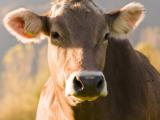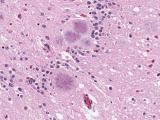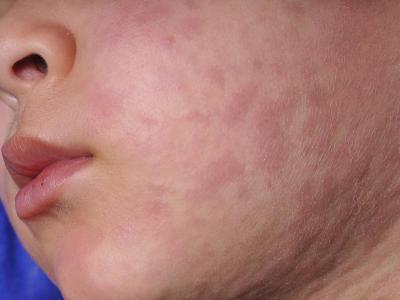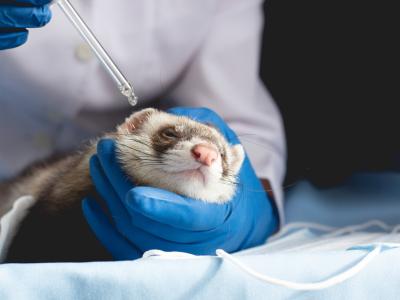Jun 28, 2005 (CIDRAP News) The United States' second case of bovine spongiform encephalopathy (BSE) was confirmed last week after a series of additional tests were run on samples from a beef cow that had originally tested negative last November.
The outcome prompted the US Department of Agriculture (USDA) to change its BSE testing protocol. From now on, two kinds of confirmatory testsimmunohistochemistry (IHC) and the Western blotwill be done when an initial rapid screening test is inconclusive, officials announced on Jun 24.
The screening test on the cow in question was inconclusive, and a confirmatory IHC test used at the time was negative. But in early June, at the request of the USDA's inspector general, a Western blot test was run and came back positive. The USDA then ran further IHC tests and also sent samples to the international BSE reference laboratory in Weybridge, England. Those tests also were positive, the USDA announced.
"Effective immediately, if another BSE rapid screening test results in inconclusive findings, USDA will run both an IHC and Western blot confirmatory test," the USDA said in a news release. "If results from either confirmatory test are positive, the sample will be considered positive for BSE."
The USDA said the infected cow was at least 8 years old, born before the government banned feeding of cattle (and most other mammalian) protein back to cattle in 1997. As previously reported, the carcass was kept out of the human food chain and was incinerated. Officials have not revealed where the cow came from.
The cow had been tested under the USDA's BSE surveillance guidelines because it couldn't walk when presented for slaughter. In the news release, USDA Secretary Mike Johanns said, "I am encouraged that our interlocking safeguards are working exactly as intended. This animal was blocked from entering the food supply because of the firewalls we have in place. Americans have every reason to continue to be confident in the safety of our beef."
At a Jun 24 news conference, USDA Chief Veterinary Officer Dr. John Clifford said, "We are quite certain we have identified the [cow's] herd of origin, but we want to be sure. So we're doing DNA testing."
A Jun 26 Associated Press report said the USDA had resisted calls for more tests on the cow after the IHC test in November was negative. The story said consumer groups and scientists had urged the agency to run a Western blot test and seek confirmation from the lab in England.
In a March letter to Consumers Union, a USDA official said the Western blot test would not have given a more accurate result and confirmation from the British lab was not needed, the AP reported.
But the USDA's inspector general, Phyllis Fong, was troubled by the conflicting results and asked for the Western blot test early in June, without Johanns' knowledge or consent, the report said. It said Johanns had been "irked" by her move.
As described by USDA at the press conference and in a fact sheet, the testing history in the case is complex.
When the confirmatory IHC test was done back in November, USDA scientists also did an additional, experimental IHC rapid test "for academic purposes," according to the fact sheet. The test showed some abnormalities, but because the test was not a validated procedure and because two approved IHC tests were negative, the abnormalities were not reported.
The Western blot test requested by the inspector general was positive the week of Jun 5. USDA scientists ran another IHC test the following week, using different antibodies from those used in the November test, and this time the result was "weakly positive," the fact sheet states.
The reference laboratory in England subsequently ran a series of tests on samples provided by the USDA. Among them was an IHC test using different antibodies from those used by the USDA in November; the result this time was positive. However, experts from the lab confirmed the accuracy of the USDA's November IHC test, concurring that the case could not have been confirmed from the sample used in that test, the USDA said.
The cow had a very low level of abnormal prion protein in the brain, and it was distributed unevenly, the agency said. Those findings may explain why the November IHC test missed the signs, officials said.
Officials also said the IHC test is not a standardized test. Dr. Danny Matthews, an official from the United Kingdom's Veterinary Laboratories Agency in Weybridge, who participated in the USDA news conference, said, "There is no single commercially available off-the-shelf IHC method at the moment. I don't think there's any two laboratories, for example, that use identical methods."
Matthews also commented, "I can't explain how the standard method at Ames [the USDA lab in Ames, Iowa] did not detect this particular case at the time."
Henceforth, USDA scientists will consult periodically with Weybridge scientists to determine which of the antibodies available for use in IHC confirmatory tests are best for use in the United States, the agency said.
Matthews and USDA officials agreed that the rapid screening test used by USDA, the Biorad ELISA, is reliable. "It's naturally assuring that most if not all of your cattle have been tested using the Biorad ELISA," he said.
He said further that the additional testing in this case has probably boosted the credibility of the USDA BSE surveillance program. "Otherwise if you had come to the wider world with data on 400,000 animals that you'd tested but you still had this unresolved [case] in the background, those people who have experience with the Biorad ELISA would have challenged that interpretation and possibly accused you of suppressing that information."
In other comments, Clifford said the "molecular protein patterns" seen in the infected cow resembled those seen in BSE cases in France but were unlike those typically seen in British cases.
News of the second US case came almost precisely 18 months after the first case was revealed on Dec 23, 2003. That case involved a Canadian-born cow in Washington state. The finding triggered a big expansion of the USDA BSE testing program, starting in June 2004.
About 388,000 animals have been tested since then. "One positive test result out of 388,000 tests in our enhanced surveillance program indicates that the presence of the disease is extremely, extremely low in the United States," Johanns said.
See also:
Transcript of Jun 24 news conference
USDA fact sheet on testing history of infected cow
http://www.usda.gov/documents/vs_bse_ihctestvar.pdf














